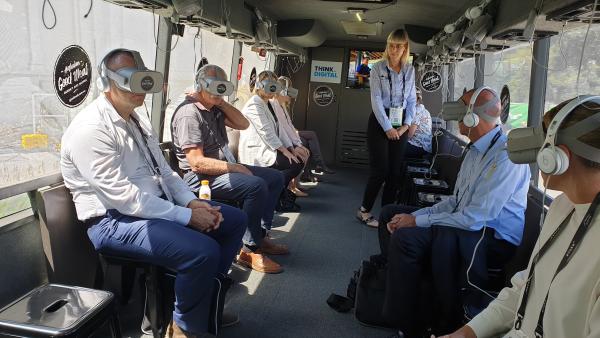Editors: Jane Trindall, Melanie Jenson (on behalf of CRDC)
Skills needed to work in agriculture are rapidly changing, and Australia needs to plan now to create industries and people ready for the future.
CSIRO’s recent Data 61 Digital megatrends report says new jobs are being created by digital technologies at such a rate that all Australian industries faces imminent and critical skills shortages. This includes the fields of data science, machine learning, human language technologies, robotics along with many others. Closer to home, Regional Development Australia has put together a Regional Job Automation Pack for the regional workforce to adjust to potential changes to the workforce. Therein lies an urgent need to develop new skills and transition careers in all industries including one of Australia’s largest - agriculture.
Staying ahead of the curve
To prepare agriculture and its workforces for the future, Australia’s Rural Research and Development Corporations (RDCs) through the Growing a Digital Future for Australian Agriculture project are working together to develop a Digital Capability Framework. This framework will guide educators to develop and deliver training to increase the digital skills required across agriculture to use and work with digital technologies.
Getting started
Using Australian Bureau of Statistics’ (ABS) agricultural workforce job role classification data across the supply chain, along with an Australian artificial intelligence analytics platform, it is possible to predict the influence that technologies and digital solutions are likely to have on the Australian agricultural workforce over the next 10 years.
A review is also underway of digital capabilities of the agricultural workforce and current training providers and curricula focusing on digital and technological training available through the vocational education and training (VET) system, universities and, increasingly, informal training provided by equipment and service suppliers and unregistered training organisations.
Leveraging the analytics platform, current state and future digital capability measures are estimated based on the current skills mix of each job and, for digital capabilities, the extent of current technology use.
Emerging Insights
Initial insights have identified the future agricultural workforce is likely to be influenced by technologies and digital solutions that will either augment or automate the way people operate. The most influential technologies likely to augment the future workforce capabilities will include navigation robotics, process automation and decision support tools.
The maturity of digital adoption varies between sectors and industry roles across the supply chain, and it is estimated that there is currently a consistent lack of proficiency in operating technologies and digital devices applicable to business activities and processes. There is also on average a slow uptake of digital solutions.
While the full range of digital capabilities will be required, the greatest level of expectation is set on data management.
The data analysis demonstrated that the workforce is aware of the value of data collection and the habit of data collection is increasing, however significant barriers remain in understanding what data is required and collecting data in a digital form to allow analysis and decision making.
The Framework
Currently there is no way to simply identify digital capabilities in Australian agriculture. The project will create a baseline to identify learning outcomes and the framework from which the industry can create education and training pathways.
The Digital Capability Framework will include:
- Digital capabilities defined as skills an individual, organisation or industry require to actively participate in current and future environments heavily reliant on digital resources and technologies. Examples of digital capabilities include digital literacy, data management and technology operation.
- Enabling capabilities such as the soft skills that enable individuals to gain basic digital capability and knowledge and promote innovative behaviour using new and advanced technologies now and in the future.
The framework will better enable the tertiary and VET sectors to deliver relevant courses and help individuals decide on the myriad of online courses from learning platforms such as Coursera, IDEO and Udacity. A recent Swinburne survey highlighted that nearly 60% of Australian employees feel personally responsible for preparing themselves for the future of work. The Digital Capability Framework will give individuals a greater level of certainty about what skills they will need in the future. Employers will be more aware of the skill areas in which they should invest.
Achieving a practical national framework will help guide ongoing RDC investments and priorities as they relate to up-skilling the agricultural workforce to better adopt technology and lift the sector’s digital maturity. This is an exciting time for the agricultural industries, with projects such as these helping the workforce realise its full potential and creating a foundation for long-term success.
The project’s role in the Growing a Digital Future Program will be discussed at a National Forum, proposed to be livestreamed from Canberra in September.
How can I get started?
We all have different levels of digital literacy and different levels of ambition. If you, like us, are impatient to get started here’s three online training resources to get started today:
- I am just getting started: Microsoft
- My workplace has upgraded to Microsoft 365: Lynda.com
- I would like specialist developer or data analysis skills: Pluralsight
- I would like to develop some machine learning applications: AI for everyone
This project is a supported by funding from the Cotton Research and Development Corporation, Meat and Livestock Australia, Sugar Research Australia, Australian Wool Innovation, Fisheries Research and Development Corporation, AgriFutures Australia, Wine Australia, Dairy Australia, Australian Pork Limited, Australian Eggs and Horticulture Innovation Australia.
This article was original published on Linkedin by Jane Trindall, CRDC's Innovation Broker.



